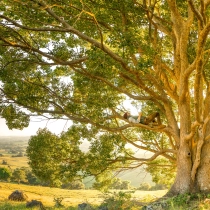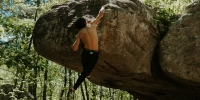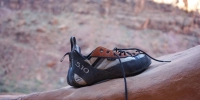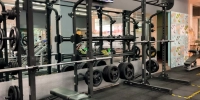Mastering Climbing Grips & Rock Features: A Comprehensive Guide

Climbing is a sport that demands a nuanced understanding of how to interact with the rock or holds. At the heart of this interaction lies the mastery of various climbing grips and the ability to effectively navigate diverse rock features. Each grip type is a specific way of holding onto a feature, optimized for different shapes, sizes, and angles of holds. Understanding and effectively utilizing these grips, combined with strategic body movement on different rock formations, is fundamental to climbing success, allowing you to conserve energy, maintain control, and conquer challenging routes.
This guide will delve into the most common and essential climbing grip techniques, explaining their mechanics and when to use them. We will then explore how to apply these grips and utilize body positioning to successfully navigate a variety of rock features, enhancing your overall climbing prowess.
- Essential Climbing Grip Techniques
- 1. Crimping (or Crimp Grip)
- 2. Open-Hand Grip (or Open Hand)
- 3. Pinching (or Pinch Grip)
- 4. Gaston
- 5. Side-Pull
- 6. Sloper
- Navigating Various Rock Features
- Other Important Grip Concepts And Techniques
- Frequently Asked Questions
- What Is Crimping In Climbing?
- What Is The Difference Between Full Crimp And Half Crimp?
- When Should I Use An Open-hand Grip?
- What Is Pinching In Climbing?
- How Does A Gaston Grip Work?
- What Is A Side-pull Grip?
- What Is A Sloper Hold?
- How Can Body Movement Help With Grip Strain?
- What Is "matching Hands" In Climbing?
- What Is Finger Jamming?
- How Do You Climb Cracks?
- What Is The Key To Climbing Overhangs?
- How Do You Prevent Slipping On Slopers Or Slabs?
- What Is Stemming In Climbing?
Essential Climbing Grip Techniques
Mastering a diverse range of grips allows climbers to adapt to any hold encountered on a route, maximizing efficiency and minimizing fatigue.
1. Crimping (or Crimp Grip)
-
Description: This grip involves placing your fingertips on a small edge, with your knuckles often bent at a sharp angle. It's a powerful grip that allows you to exert significant force on tiny holds.
-
Mechanics: There are typically two main variations:
-
Full Crimp: Your fingers are sharply bent, and your thumb is often wrapped over your index finger to "lock" the grip. This provides maximum power but puts significant stress on finger tendons.
-
Half Crimp: Your fingers are bent at a 90-degree angle at the first knuckle, but your thumb is not wrapped over. This is a strong and slightly less strenuous option than the full crimp.
-
-
When to Use: Ideal for very small edges, thin cracks, or when maximum pulling power is needed on a tiny feature.
-
Considerations: Requires significant finger strength and can be hard on tendons if overused or performed with poor technique.
2. Open-Hand Grip (or Open Hand)
-
Description: The open-hand grip involves keeping your fingers relatively flat or slightly bent, distributing the force across the entire surface of your fingers and palm. Your hand remains open, not crimped.
-
Mechanics: This grip allows for a broader contact area with the hold. It reduces the strain on individual finger tendons compared to crimping.
-
When to Use: Best for larger, rounded holds (slopers), jugs, or when you want to conserve energy on less positive holds. It's also excellent for dynamic movements where you need to quickly grab and release.
-
Considerations: Less powerful than a crimp on small edges, but much safer for finger health and more sustainable for longer climbs.
3. Pinching (or Pinch Grip)
-
Description: Pinching involves squeezing a hold between your thumb and your fingers, engaging the muscles in your forearm and thumb.
-
Mechanics: The effectiveness of a pinch relies on the opposing force between your thumb and fingers. It can be used on holds that protrude from the wall, thin fins, or even volumes.
-
When to Use: Essential for holds that are too wide to crimp or open-hand, or for features that allow for a strong opposing squeeze.
-
Considerations: Develops specific forearm and thumb strength. The size and shape of the hold will dictate how effective a pinch can be.
4. Gaston
-
Description: A Gaston grip involves pulling outwards from a vertical hold, as if you're trying to pull a door open. Your thumb is typically pointing downwards, and your elbow is bent and pointing away from your body.
-
Mechanics: This grip utilizes opposing forces, pushing with your feet and pulling outwards with your hand. It's highly effective on vertical edges or pockets.
-
When to Use: Primarily used on vertical or slightly overhanging terrain with side-pull-like features, especially when moving laterally.
-
Considerations: Requires good body tension and core strength to maximize its effectiveness.
5. Side-Pull
-
Description: A side-pull grip is used on a vertical hold that you pull directly sideways on, rather than straight down. Your body is typically positioned to the side of the hold, allowing you to pull into it.
-
Mechanics: Similar to a Gaston in that it uses lateral force, but the pull is more directly sideways. It often works best when you are moving away from the side-pull.
-
When to Use: Effective on vertical edges or pockets, particularly when you need to move horizontally or adjust your body position to reach another hold.
-
Considerations: Requires good footwork and body positioning to generate effective opposing force.
6. Sloper
-
Description: A sloper is a rounded, featureless hold that offers no positive edges to grip. Success relies on maximizing surface contact and friction.
-
Mechanics: The open-hand grip is almost always used here. You apply downward and inward pressure, trying to "stick" to the hold through friction. Body positioning, core tension, and foot placement are critical to keeping weight on the hold.
-
When to Use: Found on rounded volumes, large bulges, or smooth, featureless sections of rock.
-
Considerations: Extremely sensitive to body position, friction, and humidity. Often requires a strong core and good technique.
Navigating Various Rock Features
Beyond individual grip techniques, understanding how to apply them and manipulate your body on different rock features is crucial for efficient and successful climbing.
1. Cracks
-
Characteristics: Vertical or horizontal fissures in the rock.
-
Techniques: Primarily involve finger jamming, hand jamming, or fist jamming, where you wedge your digits or entire hand/fist into the crack and torque it to create friction and security. Foot jamming can also be used.
-
Body Positioning: Often requires a "stemming" or "lie-backing" technique, using opposing forces between limbs.
2. Overhangs
-
Characteristics: Sections of rock that lean out beyond vertical, requiring you to pull yourself into the wall.
-
Techniques: Demand significant upper body and core strength. Utilize powerful crimps and open-hand grips on positive holds. Dynamic movements are often necessary to link distant holds.
-
Body Positioning: Maintain a tight core, keep your hips close to the wall, and use efficient flagging or drop-knees to maintain balance and leverage. Overcoming fear on overhangs comes with practice and trusting your strength.
3. Slabs
-
Characteristics: Gently angled rock faces, often less than vertical, where friction climbing and precise footwork are paramount.
-
Techniques: Rely heavily on smearing with your climbing shoes and delicate foot placements on tiny irregularities. Handholds are often minimal, requiring balance and trust in friction.
-
Body Positioning: Keep your body upright and close to the rock, maintaining a high center of gravity. Distribute your weight evenly and avoid sudden movements that could break friction. Slipping on slopers or slabs often comes from poor weight distribution.
4. Dihedrals and Arêtes
-
Dihedral (Inside Corner):
-
Characteristics: An inward-facing corner where two rock faces meet.
-
Techniques: Often involves stemming (pushing outwards with opposing limbs on the two faces), or "lie-backing" (pulling on one edge while pushing with feet on the other).
-
-
Arête (Outside Corner):
-
Characteristics: An outward-facing corner or sharp edge of rock.
-
Techniques: Can involve wrapping hands around the arête, using opposing forces (like a pinch or side-pull), or "flagging" a leg to maintain balance as you move around the corner.
-
Other Important Grip Concepts and Techniques
Beyond the primary grip types and specific features, understanding how to transition between grips and utilize your body effectively is crucial.
-
Matching Hands: Moving one hand onto a hold already occupied by the other hand. This is a common technique to set up for the next move or to rest.
-
Twisting/Flagging: Using your body to create counter-balance and maintain stability, often involving twisting your hips or extending a leg out to the side (flagging) to prevent barn-dooring. This alleviates strain on grips.
-
Utilizing Body Movement to Alleviate Grip Strain: Efficient movement, precise footwork, and strong core engagement can significantly reduce the amount of force needed from your hands, allowing you to conserve grip strength. This includes flagging, drop-knees, and maintaining a strong "triangle" shape with your body.
Mastering these various grip techniques and understanding how to apply them effectively, often in combination with intelligent body movement, is a continuous journey for climbers. It's through practice and mindful application that you'll develop the versatility and strength needed to tackle increasingly complex and rewarding climbs.
Frequently Asked Questions
What is crimping in climbing?
Crimping is a grip technique where you use your fingertips on small edges, often with bent knuckles, to exert maximum force on tiny holds.
What is the difference between full crimp and half crimp?
A full crimp involves sharply bent fingers with the thumb often wrapped over the index finger for maximum power, while a half crimp has fingers bent at a 90-degree angle at the first knuckle without thumb wrap, offering a slightly less strenuous option.
When should I use an open-hand grip?
The open-hand grip is best for larger, rounded holds (slopers), jugs, or when you want to conserve energy and reduce strain on finger tendons.
What is pinching in climbing?
Pinching involves squeezing a hold between your thumb and fingers, engaging forearm muscles to create an opposing force for grip.
How does a Gaston grip work?
A Gaston grip involves pulling outwards from a vertical hold, with the thumb pointing downwards and the elbow bent and pointing away from the body, utilizing opposing forces to maintain grip.
What is a side-pull grip?
A side-pull grip is used on a vertical hold where you pull directly sideways, typically with your body positioned to the side of the hold, effective for lateral movements.
What is a sloper hold?
A sloper is a rounded, featureless hold that offers no positive edges, requiring climbers to rely on maximizing surface contact, friction, and precise body positioning to stay on.
How can body movement help with grip strain?
Efficient body movement, precise footwork, and strong core engagement can significantly reduce the amount of force needed from your hands, thereby conserving grip strength.
What is "matching hands" in climbing?
Matching hands is a technique where you move one hand onto a hold that is already occupied by your other hand, often done to set up for the next move or to rest.
What is finger jamming?
Finger jamming is a technique primarily used in crack climbing, where climbers wedge their fingers (or hands/limbs) into cracks and torque them to create a secure hold.
How do you climb cracks?
Climbing cracks primarily involves jamming techniques (finger, hand, or fist jamming) where you wedge and torque your body parts into the crack for security, often combined with stemming or lie-backing.
What is the key to climbing overhangs?
The key to climbing overhangs is maintaining a tight core, keeping your hips close to the wall, and using efficient flagging or drop-knees to maintain balance and leverage, often requiring dynamic movements.
How do you prevent slipping on slopers or slabs?
Preventing slipping on slopers or slabs relies on maximizing surface contact and friction, precise weight distribution, delicate foot placements (smearing), and maintaining a stable body position close to the rock.
What is stemming in climbing?
Stemming is a technique used in dihedrals (inside corners) where you push outwards with opposing limbs on the two rock faces to create tension and support your weight.












